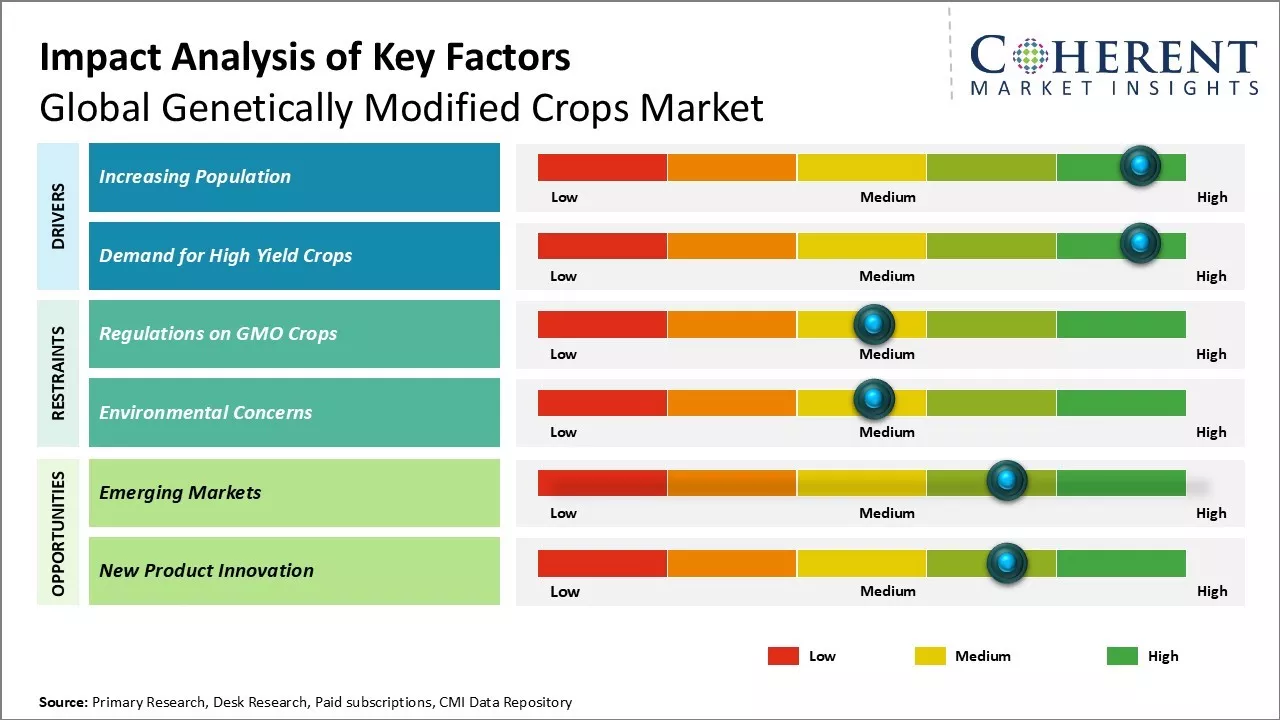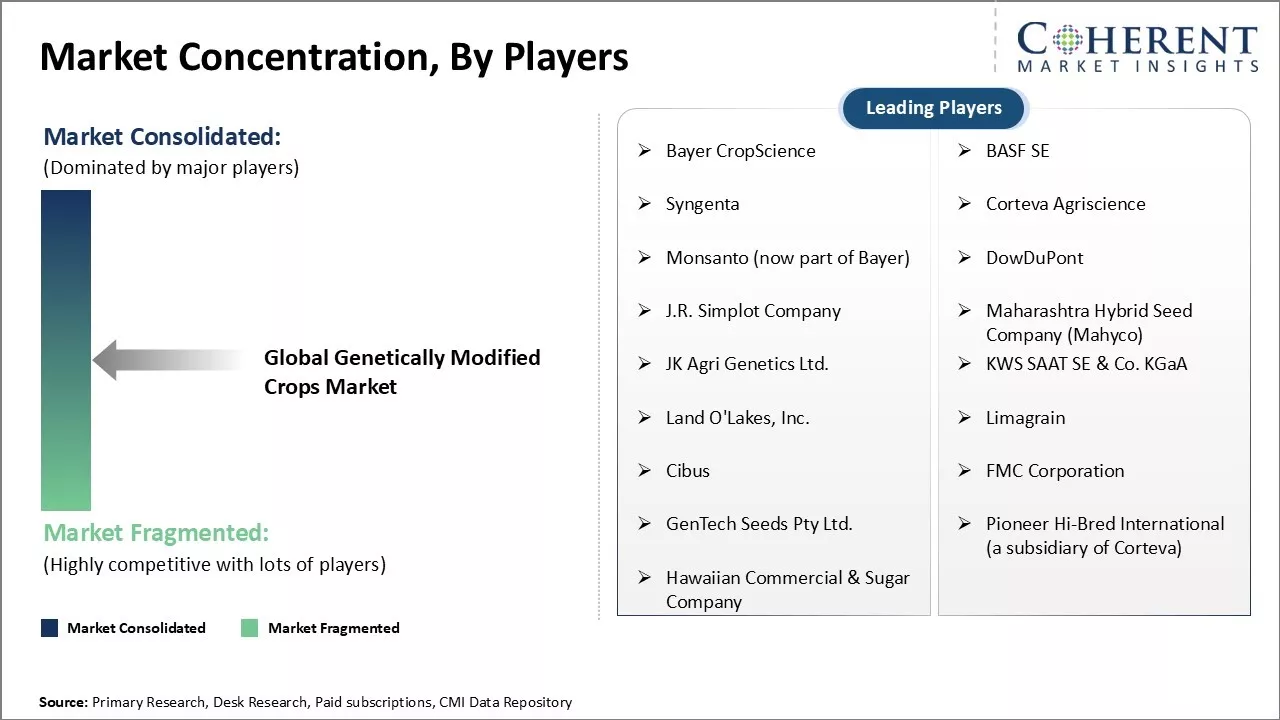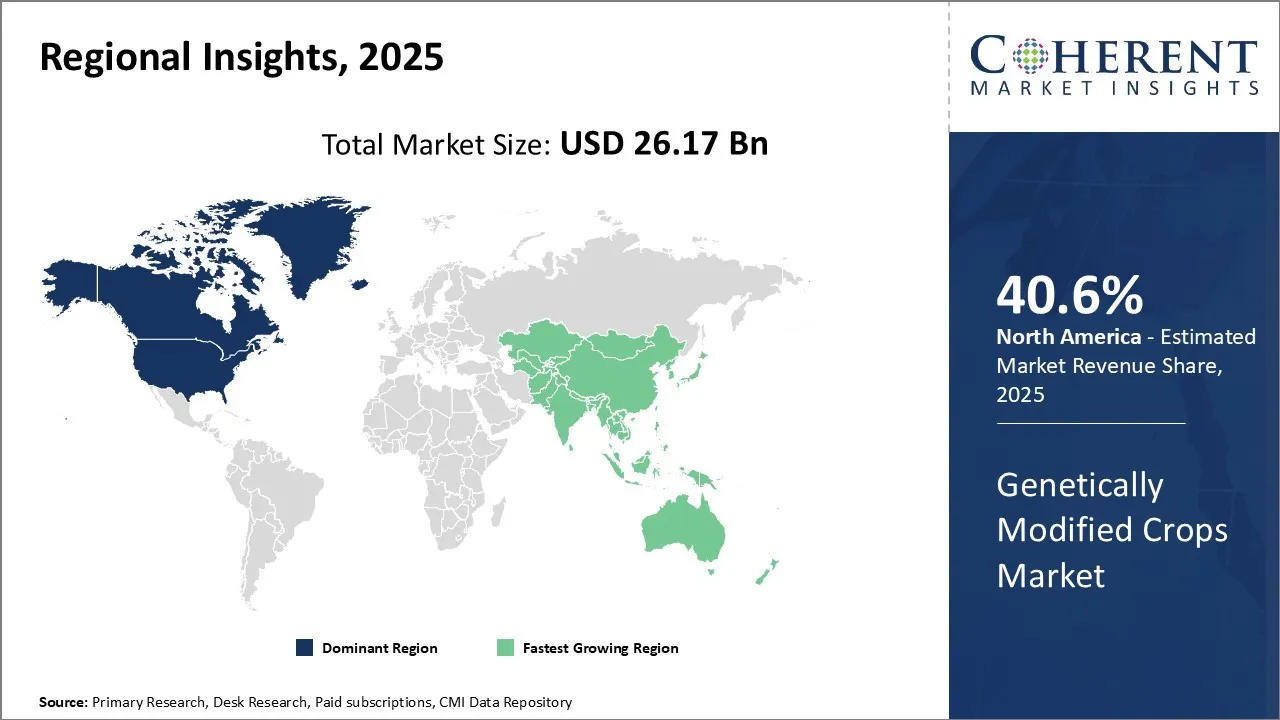The genetically modified crops market is estimated to be valued at USD 26.17 Bn in 2025 and is expected to reach USD 38.09 Bn by 2032, exhibiting a compound annual growth rate (CAGR) of 5.5% from 2025 to 2032.

To learn more about this report, Download Free Sample
Increasing demand for food, owing to rapidly growing population has intensified the need for crops with higher yields. Genetically modified crops are engineered to resist pests and diseases, and exhibit tolerance to herbicides. This allows farmers to harvest higher yields and meet the rising food demand. Additionally, genetically modified crops help reduce the use of pesticides, lowering the production cost for farmers.
However, regulatory concerns and issues related to intellectual property rights continue to restrain the market.

To learn more about this report, Download Free Sample
|
Current Events |
Description and its impact |
|
Regulatory Shifts in Major Agricultural Markets |
|
|
Technological and Collaborative Innovations |
|
Uncover macros and micros vetted on 75+ parameters: Get instant access to report
The demand for genetically modified (GM) crops is propelled by the urgent need to enhance agricultural yields and resilience amid escalating environmental pressures. Climate-induced stressors—including prolonged droughts, unpredictable precipitation patterns, and heightened pest invasions—threaten global food security. GM crops address these challenges through engineered traits that bolster productivity and reduce losses.
For instance, herbicide-tolerant (HT) varieties like glyphosate-resistant soybeans enable efficient weed management, preventing yield losses of 20-30% in developing nations. Additionally, according to Farmnaut, precision technology could boost sustainable crop yields by up to 20% while reducing water use by 15%.
One of the major challenges for the global genetically modified crops market is the stringent regulations imposed on genetically modified crops by various governments and regulatory bodies across the world. Many countries such as India, Thailand and others have imposed complete bans on cultivation and sale of certain GM crops based on health, environment, and ethical concerns. Complying with these complex and diverse set of regulations across different markets require substantial investments of time and resources for GMO seed and crop producers and developers.
In terms of crop type, corn is expected to contribute 46.9% share of the market in 2025, owing to its versatility and resilience. Corn is widely grown globally as it adapts well to a variety of climatic conditions and soil types.
It is heat and drought tolerant, giving higher yields even in adverse weather. Corn serves as a staple food and feed crop in many countries, feeding both humans and livestock. As the most widely utilized grain, corn finds applications in various food and industrial products. Its derivatives like starch, sweeteners and corn oil are major raw materials for many industries.
In terms of trait type, herbicide tolerance is expected to contribute 34.1% share of the market in 2025, due to allowing easier weed management practices for farmers. Herbicide-tolerant seeds allow broad-spectrum post-emergence chemical application to eliminate weeds without affecting the crop.
This provides a cost-effective way for growers to control weeds that compete for water, light, and soil nutrients meant for crops. Not having to carefully distinguish crops from weeds by hand during spraying saves much effort and labor. Genes inserted into crops make them resistant to major herbicides like glyphosate.
In terms of application, food and feed is expected to contribute 40% share of the market in 2025, owing to fulfilling basic human needs.
As the world population continues growing, there is mounting pressure to increase agricultural yields to meet rising food demand, for instance, according to UN Organization, the world's population is expected to increase by nearly 2 billion persons in the next 30 years, from the current 8 billion to 9.7 billion in 2050. Genetically modified crops play a vital role in enhancing global food production through built-in resistances and higher nutrient contents.

To learn more about this report, Download Free Sample
North America's dominance in the global genetically modified crops market can be attributed to several factors with an estimated 40.6% share in 2025. The U.S. and Canada have been at the forefront of the adoption and commercialization of GM crops, driven by supportive regulatory frameworks, extensive research and development efforts, and the presence of major agricultural biotechnology companies.
For instance, in 2025, the United States Department of Agriculture (USDA) reported that more than 90 percent of U.S. corn, upland cotton, and soybeans are produced using GE varieties. GE crops are broadly classified in this data product as herbicide-tolerant (HT), insect-resistant (Bt), or stacked varieties that are a combination of both HT and Bt traits.
The Asia Pacific region is the fastest-growing market for GM crops, driven by the increasing demand for food and the need to enhance agricultural productivity. Countries like China, India, and Brazil have made significant strides in the development and adoption of GM crops, particularly for staple food crops like corn, soybean, and cotton. The growing population, rising incomes, and the need to address food security concerns have contributed to the rapid expansion of the genetically modified crops in the Asia pacific region.
For instance, in June 2025, the Food Standards Australia New Zealand (FSANZ) announced the evaluation of Application A1333, which seeks approval for the use of genetically modified (GM) purple tomatoes in food. The purple tomato, developed by Norfolk Healthy Produce Inc., has been genetically modified to generate natural blue pigments (anthocyanins) during ripening, resulting in its distinct purple skin and flesh.
China is intensifying its efforts to enhance food security by expanding the cultivation of genetically modified (GM) crops. In December 2024, the country approved additional varieties of GM corn, soybeans, and cotton for domestic production, aiming to increase yields and reduce reliance on imports. The Ministry of Agriculture and Rural Affairs (MARA) has also issued safety certificates for several GM crop varieties, signaling a commitment to integrating biotechnology into agriculture
India's approach to GM crops is characterized by regulatory caution and public scrutiny. In May 2025, the government approved the commercialization of genetically modified rice varieties, a decision met with resistance from state governments and farmers' groups. For instance, Telangana's Agriculture and Farmers Welfare Commission urged the central government to withdraw its approval, citing potential harm to the state's paddy-based economy and concerns over agricultural sovereignty.
Argentina has been a leader in adopting GM crops, with over 26 million hectares planted with genetically engineered soybeans, corn, and cotton. The country has established a progressive regulatory framework, allowing gene-edited crops that do not contain DNA from another species to be regulated as conventional plants. This approach has facilitated the approval of numerous GM crop varieties, positioning Argentina as a significant player in global agricultural biotechnology.
Brazil continues to expand its acreage of genetically modified crops, particularly soybeans and corn. The country's regulatory environment supports the cultivation of GM crops, contributing to increased productivity and competitiveness in the global market. Brazil's adoption of GM technology has been instrumental in meeting the growing demand for agricultural products, both domestically and internationally.
| Report Coverage | Details | ||
|---|---|---|---|
| Base Year: | 2024 | Market Size in 2025: | USD 26.17 Bn |
| Historical Data for: | 2020 To 2024 | Forecast Period: | 2025 To 2032 |
| Forecast Period 2025 to 2032 CAGR: | 5.5% | 2032 Value Projection: | USD 38.09 Bn |
| Geographies covered: |
|
||
| Segments covered: |
|
||
| Companies covered: |
Bayer CropScience, BASF SE, Syngenta, Corteva Agriscience, Monsanto (now part of Bayer), DowDuPont, J.R. Simplot Company, Maharashtra Hybrid Seed Company (Mahyco), JK Agri Genetics Ltd., KWS SAAT SE & Co. KGaA, Land O'Lakes, Inc., Limagrain, Cibus, FMC Corporation, GenTech Seeds Pty Ltd., Pioneer Hi-Bred International (a subsidiary of Corteva), and Hawaiian Commercial & Sugar Company |
||
| Growth Drivers: |
|
||
| Restraints & Challenges: |
|
||
Uncover macros and micros vetted on 75+ parameters: Get instant access to report
*Definition: The global genetically modified crops market involves the cultivation and sale of food crops whose DNA has been modified using genetic engineering techniques. These crops are altered at the molecular level to enhance desired traits such as increased resistance to herbicides or improved nutritional content. Key players in this market develop and sell GM seeds and traits to farmers worldwide.
Share
Share
About Author
Sakshi Suryawanshi is a Research Consultant with 6 years of extensive experience in market research and consulting. She is proficient in market estimation, competitive analysis, and patent analysis. Sakshi excels in identifying market trends and evaluating competitive landscapes to provide actionable insights that drive strategic decision-making. Her expertise helps businesses navigate complex market dynamics and achieve their objectives effectively.
Missing comfort of reading report in your local language? Find your preferred language :
Transform your Strategy with Exclusive Trending Reports :
Frequently Asked Questions
Joining thousands of companies around the world committed to making the Excellent Business Solutions.
View All Our Clients